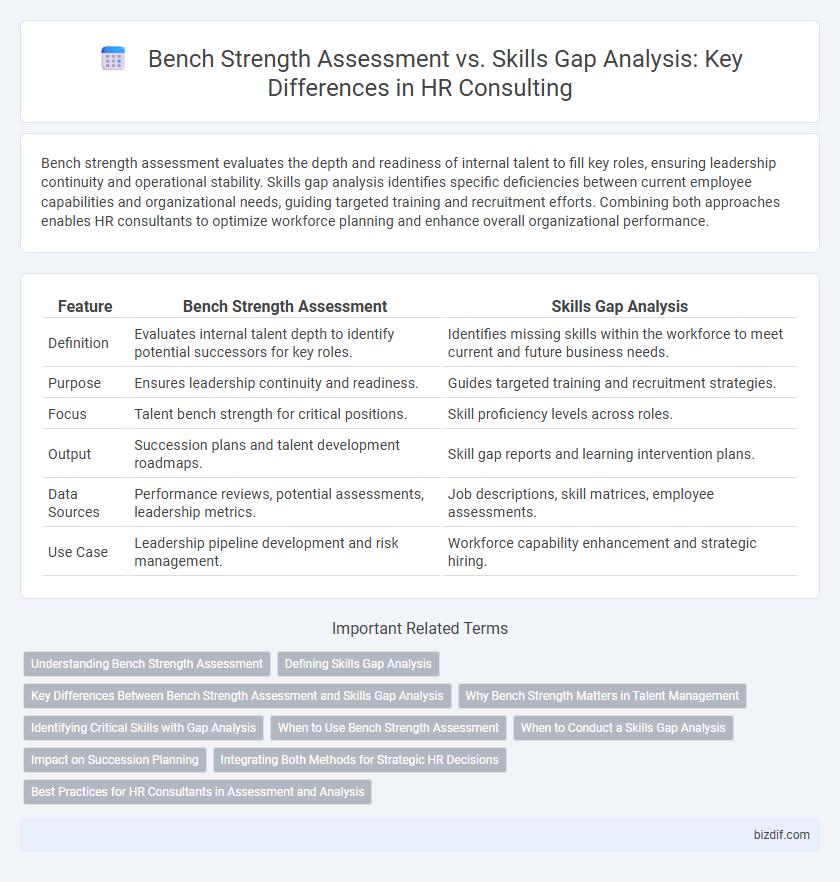Bench strength assessment evaluates the depth and readiness of internal talent to fill key roles, ensuring leadership continuity and operational stability. Skills gap analysis identifies specific deficiencies between current employee capabilities and organizational needs, guiding targeted training and recruitment efforts. Combining both approaches enables HR consultants to optimize workforce planning and enhance overall organizational performance.
Table of Comparison
| Feature | Bench Strength Assessment | Skills Gap Analysis |
|---|---|---|
| Definition | Evaluates internal talent depth to identify potential successors for key roles. | Identifies missing skills within the workforce to meet current and future business needs. |
| Purpose | Ensures leadership continuity and readiness. | Guides targeted training and recruitment strategies. |
| Focus | Talent bench strength for critical positions. | Skill proficiency levels across roles. |
| Output | Succession plans and talent development roadmaps. | Skill gap reports and learning intervention plans. |
| Data Sources | Performance reviews, potential assessments, leadership metrics. | Job descriptions, skill matrices, employee assessments. |
| Use Case | Leadership pipeline development and risk management. | Workforce capability enhancement and strategic hiring. |
Understanding Bench Strength Assessment
Bench Strength Assessment evaluates the readiness and capability of internal talent to fill critical roles, providing a clear picture of leadership continuity and workforce stability. It identifies potential successors and highlights areas where talent development is required to maintain organizational performance. This assessment supports strategic workforce planning by ensuring the company can effectively manage future vacancies and growth demands.
Defining Skills Gap Analysis
Skills Gap Analysis identifies the difference between current employee competencies and the skills required for optimal job performance, enabling targeted training and development plans. It involves systematic evaluation through assessments, performance data, and future business needs to pinpoint areas requiring skill enhancement. Effective Skills Gap Analysis supports strategic workforce planning by aligning talent capabilities with organizational goals and industry trends.
Key Differences Between Bench Strength Assessment and Skills Gap Analysis
Bench Strength Assessment evaluates the depth and readiness of internal talent to fill critical roles, focusing on succession planning and leadership pipeline strength. Skills Gap Analysis identifies specific discrepancies between current employee skills and those required for business objectives, targeting training and development needs. The key difference lies in Bench Strength assessing overall talent capacity for future roles, while Skills Gap Analysis diagnoses particular skill deficiencies impacting performance.
Why Bench Strength Matters in Talent Management
Bench strength assessment identifies critical talent ready to fill key roles, ensuring leadership continuity and minimizing business disruption. It supports strategic workforce planning by revealing the depth of internal capabilities for future organizational needs. This approach strengthens talent pipelines, reduces recruitment costs, and maximizes employee retention through targeted development initiatives.
Identifying Critical Skills with Gap Analysis
Skills Gap Analysis precisely identifies critical skills deficiencies within an organization, enabling targeted development plans that enhance workforce capabilities. By comparing existing employee competencies to future business needs, HR consulting firms create actionable insights that improve talent deployment and succession planning. This focused approach ensures organizations maintain robust bench strength by addressing shortages before they impact performance.
When to Use Bench Strength Assessment
Bench Strength Assessment is essential when organizations need to evaluate the readiness of internal talent to fill critical leadership or key operational roles, ensuring business continuity and succession planning. Use this assessment during strategic workforce planning or before major organizational changes to identify potential leadership voids and develop targeted development programs. It is most effective for measuring depth of talent, leadership pipeline strength, and internal promotion readiness within specific departments or business units.
When to Conduct a Skills Gap Analysis
Conduct a Skills Gap Analysis when an organization faces changing business goals, technological advancements, or expansion into new markets, requiring updated employee capabilities. This analysis identifies specific skill deficiencies hindering performance, enabling targeted training and recruitment strategies. It complements Bench Strength Assessment by focusing on individual skill development rather than overall leadership readiness.
Impact on Succession Planning
Bench Strength Assessment identifies high-potential employees ready to fill critical roles, directly strengthening succession planning by ensuring leadership continuity. Skills Gap Analysis highlights specific competencies lacking across teams, enabling targeted development programs that prepare future leaders. Together, these methods optimize succession planning by aligning talent readiness with organizational strategic goals.
Integrating Both Methods for Strategic HR Decisions
Integrating Bench Strength Assessment with Skills Gap Analysis enables organizations to identify not only current leadership capabilities but also the specific competencies needed for future growth. This combined approach provides a comprehensive view of employee potential and development areas, facilitating targeted talent management and succession planning. Using both methods strategically enhances workforce readiness and aligns HR initiatives with organizational goals.
Best Practices for HR Consultants in Assessment and Analysis
Effective HR consulting involves utilizing Bench Strength Assessment to evaluate internal talent readiness for key roles and Skills Gap Analysis to identify specific competency shortfalls impacting organizational goals. Best practices include integrating data-driven tools, conducting comprehensive employee performance reviews, and aligning assessment outcomes with strategic workforce planning. Combining these approaches ensures targeted development plans, optimized talent pipelines, and enhanced organizational agility.
Bench Strength Assessment vs Skills Gap Analysis Infographic

 bizdif.com
bizdif.com